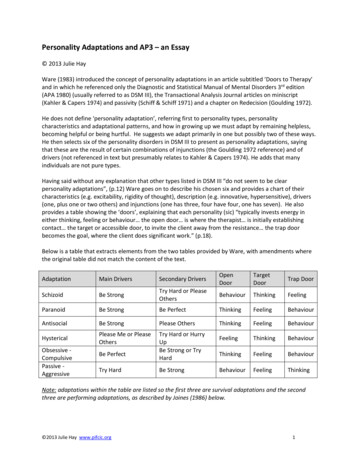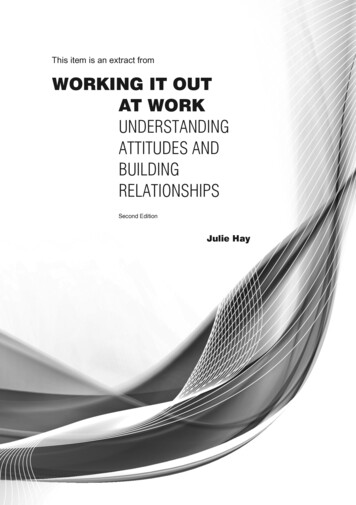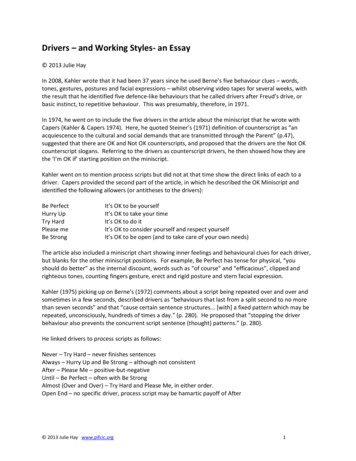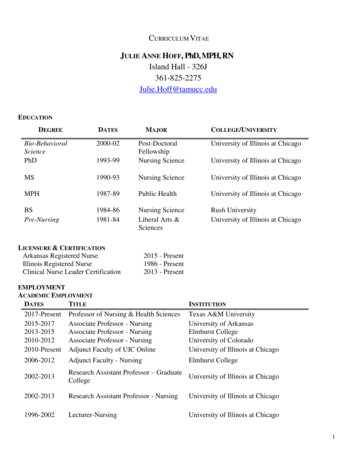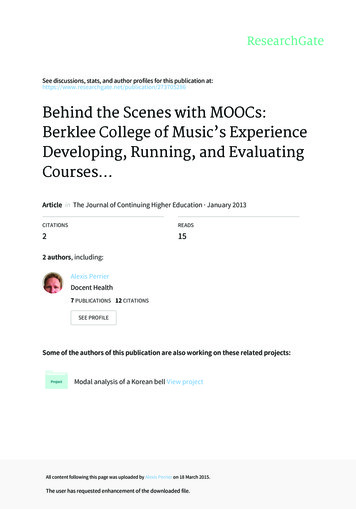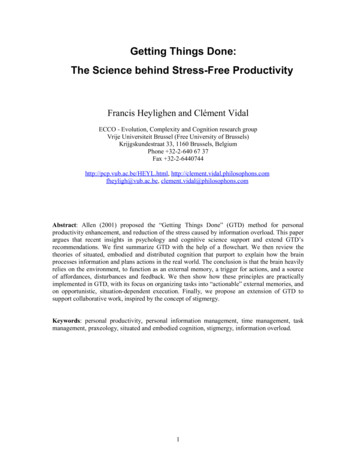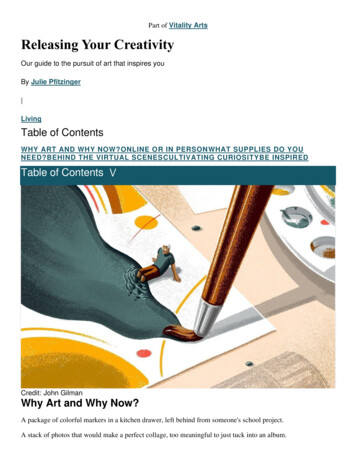
Transcription
Part of Vitality ArtsReleasing Your CreativityOur guide to the pursuit of art that inspires youBy Julie Pfitzinger LivingTable of ContentsWHY ART AND WHY NOW?ONLINE OR IN PERSONWHAT SUPPLIES DO YOUNEED?BEHIND THE VIRTUAL SCENESCULTIVATING CURIOSITYBE INSPIREDTable of Contents Credit: John GilmanWhy Art and Why Now?A package of colorful markers in a kitchen drawer, left behind from someone's school project.A stack of photos that would make a perfect collage, too meaningful to just tuck into an album.
The piano that is now only just a surface for picture frames and hasn't made music for quite some time.A surprise gift in the mail from a friend — a colorful embossed journal — with a note, featuring a GeorgiaO'Keeffe painting, that says "You seem like someone who could write a good story."A virtual tour of the Louvre, its wonders unfolding on your computer screen.Every day, the potential for creating and appreciating art is all around us.Since early 2020, we've all been challenged to see the beauty in daily life because daily life has changedconsiderably. It's been a year of uncertainty, loss, isolation, sadness and fear.But in the resilient spirit of creativity, new opportunities have come to light: beautiful Zoom musicalperformances by artists like Yo-Yo Ma, virtual art classes at places such as The Museum of Modern Art in SanFrancisco (SFMOMA), the eclectic variety of theatrical experiences from Lincoln Center in New York City andmany more.
At Next Avenue, we believe in the power of art to bring joy, healing, creativity, purpose, friendship and a senseof accomplishment to life. Art can raise our spirits.Perhaps finding the way toward art looks different at the present time; to find creativity, we all haveto be creative as we search for classes and programs that will be right for us now."I know the world is bruised and bleeding, and though it is important not to ignore its pain, it is alsocritical to refuse to succumb to its malevolence. Like failure, chaos contains information that can lead toknowledge - even wisdom. Like art." – Toni Morrison, writerInspiration is out there. We want to help you discover it.Credit: John GilmanOnline or In Person: Finding the Right Class for YouA spacious painting studio, a comfortable room in a community center or library, a music salon or dance studio— these are the places where classes in the arts are traditionally held.However, thanks to the creative use of a variety of social platforms (Zoom and others) by teachers who stillwant to connect with and inspire students, classes, lectures and more can be experienced virtually. Writing,painting, drawing, yoga, collage-making, singing — what do you want to try?One of the unexpected benefits? Location no longer matters.A novice watercolor student in Iowa can take an online class from an experienced teaching artist in Florida. Orwith a collection of natural items from a Chicago backyard, paired with the smart and warm instruction offeredin a step-by-step virtual class by a teacher in Los Angeles, an artist is born.
There are many online resources available: some are subscription-based, ideal if you finish one course and wantto take another.Programs like The Virtual Instructor offer a free trial of their painting and drawing classes, asdoes Skillshare and Udemy, which offer courses beyond art.Flora Bowley, an artist based in Portland, Ore., has a curated collection of art instruction videos, ( 18 persession) which she created in the first few weeks of the pandemic.Or check out The Art Assignment, by PBS Digital Studios, a wealth of creative videos spotlighting manyfascinating art topics such as "Art You Can't Get To" and "Eat Like Andy Warhol," along with opportunities totake on your own projects.The Craft Contemporary museum in Los Angeles is offering virtual craft tutorials where participants canassemble items on their own (leaves, sticks, fabric and more) and follow step-by-step instructions from museumstaff on how to turn these basic ingredients into art.Local libraries and community centers are also offering virtual programs. The Queens Public Library in Queens,N.Y., has many options for adults, including a recent Art History Series led by an art historian. Speaking oflibraries, most are offering curbside service, so you can keep reading which might inspire you to start writing.As the world eventually returns to the "new normal," people will once again gather for music, art, dance, theaterand other art experiences. But maybe some who began to participate in online classes during the pandemic willcontinue to seek them out."Life starts to look different when you get past fifty. It's the perfect time to discover your hiddentalents." – Angela Burton, founder, Feet to the Fire Writers' WorkshopsSome teachers will likely continue to offer online options to save the overhead costs of maintaining an art studioor to be responsive to older adults who would prefer not to gather in large groups for health reasons.If you've found an online art class you like, follow the artist on Facebook or check out their website to see if theclasses will continue in that format.Classes Indoors and OutWhile there are local art centers currently offering in-person classes, COVID-19 restrictions are firmly in place.For example, at the Textile Center in Minneapolis, a nationally-known fiber art center, no more than 10 studentswill be allowed in classrooms which have all been set up for social distancing (students will sit alone at sixfoot-long tables). Masks and gloves are required, and other protocols have been established.If you are interested in taking an in-person class, check with the art program or teacher to find out about theirCOVID-19 precautions.Another option is to take your budding talent outdoors and paint en plein air, in the spirit of Impressionistmasters such as Claude Monet.The benefits of painting en plein air are many, according to teaching artist Susan Nicholas Gephart, 62, fromBellefonte, Pa., who has been painting for 40 years.Gephart enjoys it as a singular pursuit and also finds pleasure in working with students who participate in her enplein air workshops. (In the wake of the pandemic, Gephart is now offering classes and workshops online.)"I'm visually inspired by everything that is around me." – Susan Nicholas Gephart, teaching artist
"When I am by myself, it's all about serenity, connecting with the place I'm in and with the outdoors, andabsorbing all of that into my spirit," she says. "I'm visually inspired by everything that is around me."Take an easel and a canvas to a local park, or even just out to your own backyard, and create.Credit: John GilmanWhat Supplies Do You Need?You've signed up for an art class. Now what?If you're someone who relished the thought of purchasing brand-new school supplies at the beginning of aschool year, you might be inclined to order everything in sight.But according to Gephart, it's best to start with the basics. "I don't want people to spend hundreds of dollars ontools they won't need," she says.Each class and teacher will offer their own list, but here's an idea of where to begin.Supplies for a Drawing ClassJournal/sketchbookDrawing pencils (four to six minimum, #2 or HB, which relates to the level of graphite)Erasers: rubber, kneaded and gumPencil sharpenerContainer for suppliesSupplies for a Writing Class
Notebook or journal Pens or pencils Highlighter Post-it notesWhere Do I Buy Art Supplies?Here are 5 national art supply stores: Blick — nationwide locations and online Michaels — nationwide locations and online Utrecht — online Jerry's Artarama — online North Light Shop — onlineMany communities have independent shops with knowledgeable staff members, specializing in all types ofartistic endeavors. Here's just one example: String Thing Studio, a Black-owned business in Brooklyn, N.Y.,features classes, gorgeous yarn and kits, which can also be ordered online.Google "art supply stores near me" and you should find some suggestions. Ask if the company or shop offersshipping or curbside pick-up options.Behind the Virtual Scenes of the MuseumThe still and silent spaces of art galleries around the world became even more so with the onset of thepandemic, as many shuttered. While some, like the Minneapolis Institute of Art (Mia), are cautiously reopening(while also offering virtual experiences), others remain closed.However, in the spirit of resiliency, many museums, galleries and art centers have been offering everythingfrom Zoom Q&As with artists (The Hannan Center in Detroit sponsored an Emerge! Art Festival) to lectures,online tours and more.At the Pennsylvania Academy of the Fine Arts (PAFA) in Philadelphia, which is offering online programmingand is scheduled to reopen in September 2020, they have always had a large percentage of students who are 50and older."When people come to the point where they are no longer building their careers, they have the time and energyto explore the other parts of who they want to be," says Monica Zimmerman, vice president of public educationand engagement at PAFA. "Based on the interests they've had during their lifetimes, they could have beenseventeen other people, and many want to find out just who else they can be.""Art doesn't matter if it doesn't have an audience." – Monica Zimmerman, Pennsylvania Academy of theFine ArtsSteeped in art history, Zimmerman says PAFA's art appreciation classes offer the chance to examine "littlecultural snapshots of moments in time" as participants learn about the roles of women artists in history, forexample, or how contemporary art is frequently "a window into where we want to go.""Curators don't know more than you do. The only thing that matters is what you see when you look at a work ofart," Zimmerman explains. "Art doesn't matter if it doesn't have an audience."
Even if that audience is a virtual one."Step" Inside Museums Across the CountryWhile some museums have opened their doors again, check their websites for details of their virtual programs.And be sure to check the sites of your local museums and see what they have to offer, either in person or online.Here are just a few from around the country: Art Institute of Chicago Saint Louis Art Museum Montclair Art Museum (Montclair, N.J.) Portland Art Museum (Portland, Ore.) Museum of Fine Arts (St. Petersburg, Fla.)Another option? How about an experience more aural than visual? In 2016, Tamar Avishai launched herbiweekly podcast, "The Lonely Palette," which has recorded several episodes at the Museum of Fine Arts inBoston. With each installment, the listener can become immersed in the experience of standing directly in frontof a work of art.Of the more than 45 podcasts Avishai has created, Episode 24: Meditations on Mark Rothko, is one of herpersonal favorites, focused on the American abstract expressionist (1903-1970). Read this Next Avenuestory about "The Lonely Palette" to learn more.Cultivating Curiosity and Openness
A curiosity and an openness. For teaching artist and painter Morgan Samuel Price, of Altamonte Springs, Fla.,these are essential ingredients for those who want to begin an art class of any kind.Even if you've taken art before, Price believes, you need to set a new starting point. And she says a good teacherwill help you move forward."As a teacher, I can present the information, and then the student can learn the concept, but the application ofthe concept is where the work lies," Price says.Price, who has been teaching for more than 20 years and just opened what she's calling her "online art studio"for virtual learning, says there is a bit of a need to be "a cheerleader" when you are a teaching artist.Frustration can be a reality when you're learning something new, Price says, adding that she took up singingwhen she was 50, which she found challenging.In Price's view, the point of taking an art class is to indulge in the "emotional rest" the experience can offer, andshould be a peaceful endeavor, especially for those most in need of that."I recommend painting for anyone grieving a loss," Price says. "You can disappear into the color."For all new students, if you keep practicing and lean on the passion that brought you to the art in the first place,"you will get there and you'll know it," says Price.T Mychael Rambo believes that by tapping into our creative power, we can offer others a glimpse into ourauthentic selves."We don't live in a culture based on self-expression in an outward fashion," says Rambo, a Black EmmyAward-winning theater professor, arts educator, vocalist and community organizer in Minneapolis. "Peoplewant to show what's inside of them.""Expect some classes to go better than others. Give yourself permission to keep learning." – MorganSamuel Price, teaching artistWhat Rambo, a company member of the Penumbra Theater, sees in his students age 50 is a desire to "reengage and re-energize." By developing the skill set he offers in his creative dramatics classes throughout theTwin Cities (currently on pause due to the pandemic), the students have the opportunity to use theirimaginations and their bodies in new ways.And a new freedom: "When we open up to creativity, we can ask ourselves 'What does it mean to be a tree?' or'What does it mean to really sing a song?'" Rambo says.Rambo calls the word "theater'"an action verb, as in, "To theater is to do, to be present to, to be alert to oursurroundings and to be more aware as we age."Instagram Influencer Debra Rapoport on Living CreativelyDebra Rapoport, 74, is an eco-friendly style icon who lives in New York City. Fashion is her favoriteexpression of creativity. Her focus is on layered textiles related to the body, and some of her work is in thecollections of the Metropolitan Museum of Art, the Philadelphia Museum of Art and the Houston Museum ofFine Arts.In Rapoport's words, "Where there is creativity, there are no rules — and where there are no rules, there is nofear!"
So, start here: Rapoport says getting dressed is an act of play. Open your closet door, and look for what'sspeaking to you in that moment. Who am I today? What color feels right? In the mood for a print? Do you wantsomething warm? Something silky? Something light and cool?"I equate creativity with joy. More creativity, more joy!" –Debra Rapoport, Instagram influencer"Putting together your outfit for the day is like creating a painting. You can do no wrong," she says.Rapoport has also become known for her hats. Some are made from the simplest of materials including papertowels. Adding bits and pieces of fabric, lightweight metals and other accessories that catch her eye, in additionto coloring the "fabric" in whatever hue suits her, lead to the creation of fun and fanciful headgear.Be Inspired: Vitality Arts Stories on Next AvenueSince launching eight years ago, Next Avenue has featured a host of stories about the arts. From music to dance,from pottery to filmmaking, from singing to writing, we've discovered talented artists age 50 across thecountry who can serve as a source of inspiration to anyone beginning their own artistic journey.Here are eight stories of creators, makers, musicians and more. Look for additional stories on the VitalityArts page on Next Avenue.1. A Conversation in An Artist’s Studio2. 50 Filmmakers Capture Their Stories3. Painting a Picture with Words4. Where Older Adults Write Their Own Stories5. The Creative Art of Quilting6. Music Matters for Older Adults7. An Artist Displays ‘Serious Whimsy’8. It’s OK to be Just OK at Making Art
Credit: John GilmanSome Final Thoughts on Art NowWe'd like to give you a glimpse into Next Avenue's "creative process" when it came to compiling this"Releasing Your Creativity" guide.The original version, written in February 2020, was focused on what it's like to participate in an art class andhow that might take you out of your comfort zone in the best way possible; how to find community in a groupof other art enthusiasts and how spending time in an art museum or attending an art appreciation event in agallery can help broaden your horizons and forge connections with others.The pandemic and quarantine changed that narrative. So, we had to "go back to the drawing board," so to speak,and create a guide that would be inspirational about the power of bringing art into your life, but also practicalabout our world right now."You can't use up creativity. The more you use it, the more you have." - Maya Angelou, writerIf you want to create art, there is a way. If you want to find a community of other artists, who you might meetvia Zoom, you can do that, too. And if there are galleries and classes in your area taking the appropriate safetyprecautions, those are available as well.We hope you'll be inspired to find the right way for you.SHARE
Julie Pfitzinger is the editor for Next Avenue’s lifestyle coverage across the Living and Technologychannels. Her journalism career has included feature writing for the Star-Tribune, as well as severallocal parenting and lifestyle publications, all in the Twin Cities area. Julie also served as managingeditor for nine local community lifestyle magazines. She joined Next Avenue in October 2017. Reachher by email her at jpfitzinger@nextavenue.org. Read MoreEditors RecommendationsTelling Our Stories: A Guide to Writing Your Own StoryFind Creative Inspiration Online During Quarantine
The Case for Creative Self-ExpressionSupport Nonprofit JournalismNext Avenue brings you reliable stories, special features, videos and resources on issues that matter most as weage. Your generous donation will help us continue this work and keep it free of charge. Show your supporttoday and experience the benefits of being a Next Avenue member.DonateLearn About Next Avenue
Apr 04, 2021 · Bellefonte, Pa., who has been painting for 40 years. Gephart enjoys it as a singular pursuit and also finds pleasure in working with students who participate in her en plein air workshops. (In the wake of the pandemic, Gephart is now offering classes and workshops online.)
